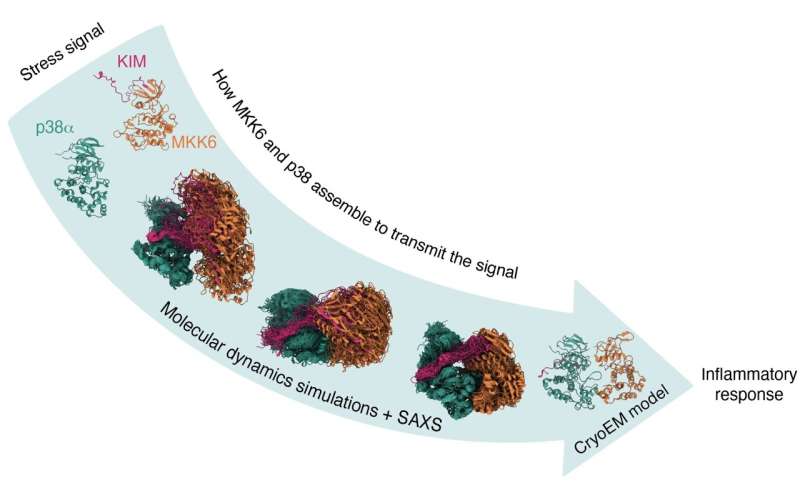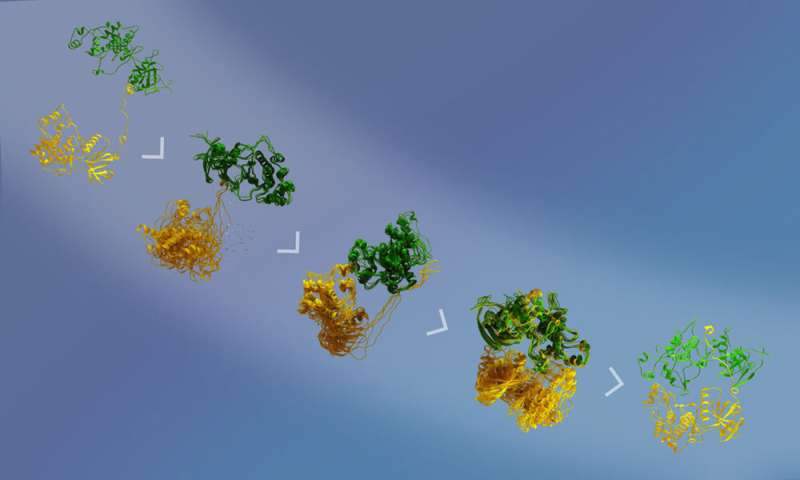This article has been reviewed according to Science X's editorial process and policies. Editors have highlighted the following attributes while ensuring the content's credibility:
fact-checked
peer-reviewed publication
trusted source
proofread
Researchers shed light on the molecular activation of the MAP kinase p38α cytokine storm 'switch'

Constant exposure of cells to stressing agents, such as pathogens, may disturb an organism's normal functioning. To fight stress, cells have developed several coping mechanisms, including the inflammatory response.
While inflammation is necessary, too much of it can impair cell and organ function. This is the case with cytokine storms—inflammatory cascades during an infection that can spiral out of control and lead to severe disease and even death, as recently highlighted during the COVID-19 pandemic.
In a paper published in Science, EMBL Grenoble and University of Geneva researchers provide essential insights on a protein called p38α, belonging to the Mitogen Activated Protein Kinase (MAPK) family, which is an important cellular 'switch' triggering the inflammatory response. They have obtained the first structure of p38α being activated by another regulatory protein kinase—MKK6—opening up new directions to develop drugs to stop cytokine storms.
The final switch: A drug target
Matthew Bowler, a researcher at EMBL Grenoble, has been studying kinases for more than a decade. This group of enzymes plays an important role in regulating complex processes in the cell by acting as a 'switch' to transmit signals and activate gene expression. They do so by phosphorylation—adding a chemical group, phosphate, to other molecules to modulate their function.
Bowler's work particularly focuses on MAP kinases, key players involved in the inflammatory response. Inflammation is switched on via a series of kinases, which activate each other in a cascade of reactions, the final kinase in the series being responsible for activating gene transcription required for inflammation. This process releases cytokines, pro-inflammatory signaling molecules, which, in case of overactivation, can lead to cytokine storms.
This kinase chain reaction is well regulated and is similar to a logic circuit: the inflammation response requires specific buttons to be switched on, ultimately activating p38α—the meeting point where all the signals converge and the last switch of the inflammatory process.
Because the kinase chain reaction can come from different 'branches' of the logic circuit, this last switch is a particularly relevant drug target. The inflammatory response is regulated by p38α and is highly activated during a cytokine storm. Inactivating it could prevent inflammation from occurring, instead of trying to treat it while it is already underway.
Protein kinases, including p38α, have therefore been heavily studied. The first protein kinase structure was solved 30 years ago—a landmark in the field—and many more structures have followed, with over 7,000 structures now available in the Protein Data Bank.
However, important parts of the puzzles are still missing. "Structural biologists have obtained detailed information on the structure and functions of protein kinases, but mostly in isolation. So we don't really know how these enzymes are activated along the chain reaction," explained Bowler.
Without this essential information about how the activation is triggered, drugs have mostly targeted the kinases' nucleotide-binding site—a common and well-known pocket present in all kinases, where the phosphate transfer occurs. The lack of drug specificity due to a common binding site across kinases means that a drug designed to stop one kinase from signaling could also stop others. This presents a problematic side effect, considering the essential role of kinases as key regulators in cellular processes.
"There are many molecules that have been designed to target p38α, especially its nucleotide-binding site, but none have yet made it past clinical trials due to this lack of specificity," added Bowler.

Cracking the activation mechanism
Bowler and a former Ph.D. student in his lab, Erika Pellegrini, have therefore been investigating the interactions between p38α and MKK6—the kinase which activates it—since 2009. But studying the interaction between kinases proves to be extremely complex. "These enzymes are very dynamic molecules; they transmit important signals and need to act quickly. In the case of p38α, it has to go into the nucleus and activate lots of other different proteins," said Bowler.
They were hampered by the fact that the interactions of the MKK6-p38α complex cannot be determined by macromolecular crystallography, a structural biology technique often employed to investigate proteins but that is particularly challenging to apply in the case of such dynamic proteins.
Recent developments in cryo-electron microscopy (cryo-EM), particularly during the last decade, raised new hopes. In 2016, Bowler and new Ph.D. student and first author of the paper, Pauline Juyoux, decided to switch to this technique—even though the protein complex was at the time considered too small for cryo-EM analysis. They were supported by Pellegrini, who had acquired expertise in this technique.
Tenacity and collaboration were key contributors to project success. "There were a lot of ups and downs, but there were always inspiring people or moments—one of these being particularly memorable," remembered Juyoux. "We obtained the first low-resolution 3D negative stain model on the exact same day that the Nobel Prize was announced for cryo-EM in 2017. It gave us a boost of motivation!"
Using cryo-EM and complementary techniques, such as X-ray crystallography and small-angle X-ray scattering (SAXS) at the European Synchrotron Radiation Facility and Diamond Light Source, the team managed to obtain the 3D structure of the complex and identify a previously unknown docking site where the two enzymes interact—crucial information for understanding how p38α is activated.
"This could be an interesting target for inhibitors that block this specific interaction, and consequently the signal triggering the inflammatory response," explained Juyoux.
A collaboration with the Gervasio Lab from the University of Geneva, which uses molecular dynamics simulations, supported Bowler, Pellegrini, and Juyoux in giving further insight into how the two kinases interact.
"They showed that the model we had generated was compatible with the enzymatic activity and that the phosphorylation site was at the right distance from the active site," explained Juyoux. "They also classified the different types of conformations of the complex to show how they assemble."
Crucially, by comparing these simulations with the SAXS data they were able to model how the two proteins interact prior to catalysis. "The beauty of combining the state-of-the-art simulations with SAXS and cryo-EM data through advanced statistical approaches is that we can 'see' the dance of the two kinases approaching one another, while knowing that what we see in the computer is fully supported by all the experimental data available," explained Francesco Gervasio.
"The simulations required several months of supercomputing time generously allocated by the Swiss National Supercomputing Center," he continued, "But it was well worth it, given the relevance of the final results."
These results provide an alternative drug target site to explore and also open the door to studying similar processes in two other families of MAP kinases: ERK kinases—which are involved in cancer—and JNK kinases—also involved in inflammation, especially in Alzheimer's disease.
"Kinases are very similar to one another in terms of sequence and structure, but we don't know how and why they respond or send a specific signal," said Juyoux, whose current research project as a postdoctoral fellow at Institut de Biologie Structurale in Grenoble focuses on JNK kinases. "Comparing these different families of kinases could help explain the specificity of interactions and lead the way to new therapeutic approaches."
More information: Pauline Juyoux et al, Architecture of the MKK6-p38α complex defines the basis of MAPK specificity and activation, Science (2023). DOI: 10.1126/science.add7859. www.science.org/doi/10.1126/science.add7859
Journal information: Science
Provided by European Molecular Biology Laboratory




















